| "The Air Nomads detached themselves from worldly concerns and found peace and freedom." |
| — Iroh to Zuko on the nature of the Air Nomads.[1] |
Air Nomads is a collective term for a nation of people who practice the discipline of airbending. One of the four major nations, the Air Nomads were wanderers by definition, but had four air temples, one at each corner of the globe, hidden away atop mountain ranges in the northern Earth Kingdom and on three remote islands. The theocratic Air Nomads were home to a monastic order of men and women who practiced airbending. Unlike the other nations, the people of the Air Nomads were, without any seen exception, all benders due to the high level of spirituality of their people.
The Air Nomads were a peaceful race who were wiped out by the Fire Nation. They lived in large temples and traveled the world on flying bison. They were the most spiritual of all the cultures and lived in harmony with nature. They also were fun-loving and had a strong sense of humor.[1]
The Air Nomads made up the smallest of the four nations in the world. They had a small economy, based entirely on limited agriculture. The population of the Air Nomads was small compared to even the Water Tribe and was far smaller than either of the world's two major powers, the Fire Nation and the Earth Kingdom.
In 0 AG, the Air Nomads were the victims of genocide at the hands of the Fire Nation. Ironically, the sole known survivor of the massacre was the very person the Fire Nation sought to kill in its quest for supremacy: the twelve-year-old airbender and Avatar, Aang, who had run away from the Southern Air Temple shortly before the Hundred Year War began and became trapped in suspended animation in a globe of ice along with his lifetime friend, Appa.[2] One hundred years later, he was awakened and released by Katara and Sokka, who helped him succeed in his quest to restore balance and peace to the warring nations.
After the Hundred Year War, Aang found several flying bison and ring-tailed winged lemurs. Elsewhere, a group named the Air Acolytes was formed to carry on the teachings, culture, and traditions of the Air Nomads. Having restored the buildings to their former glory, they occupy the air temples, along with the newfound flying bison and ring-tailed winged lemurs. The Air Nation also had a representative on the United Republic Council, a spot held by an Air Acolyte and later Tenzin until 171 AG.[3]
In 171 AG, after the Harmonic Convergence, nonbending individuals across the world began manifesting newly acquired airbending abilities. Tenzin began to train a group of airbender volunteers into a new generation of Air Nomads, in order to fortify a still recovering Air Nation and to perpetuate the bending traditions of its culture.[4] After the Insurrection of the Red Lotus, Tenzin decided that the Air Nation would roam the world, helping people of all nations to stop corruption and disorder.[5] In 174 AG, the new Air Nation continued to prosper, as more and more people who gained airbending abilities were trained in the art on Air Temple Island.[6]
History
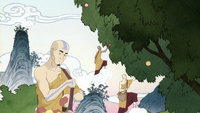
The ancestors of the Air Nomads gathered fruit from the Spirit Wilds using airbending.
Origin
In the era of Raava, ancestors of the Air Nomads received the element of air from lion turtles that granted the bending art through energybending. They could request the ability whenever they ventured into the Spirit Wilds, to aid in the gathering of food and resources. Unlike people from other lion turtle cities, the first airbenders coexisted harmoniously with the spirits and demonstrated great respect and understanding of spiritual matters. These people eventually formed the first Air Nomads after the lion turtles renounced their roles as protectors of mankind in 9,829 BG. At this point, the ancestors of the first Air Nomads left the lion turtle cities in favor of establishing temples in all four corners of the globe.
Extinction
- Main article: Air Nomad Genocide
Twelve years after the passing of Avatar Roku, Fire Lord Sozin used a comet, later named Sozin's Comet, to enhance his armies' firebending abilities to eliminate the Air Nomads, the next nation in the Avatar Cycle to achieve his goal of world domination. The high monks anticipated a war coming and the Council of Elders of the Southern Air Temple decided to reveal to Aang his identity as the Avatar prematurely at age twelve as opposed to the standard sixteen. His airbending training was subsequently intensified despite already having earned his mastery tattoos. The revelation made Aang feel his childhood was taken away from him and everyone suddenly treated him differently. When the monks attempted to separate Aang from his master and father-figure, Gyatso, to complete his airbending training at the Eastern Air Temple, Aang, having overheard the conversation, ran away on his bison, Appa. They accidentally got caught up in a storm and crashed at sea. While sinking, Aang unconsciously entered the Avatar State, freezing himself and Appa in a sphere of ice, which kept him alive for the next century. Meanwhile, the Fire Nation was successful in wiping out the Air Nomads, though was unable to find the Avatar.[2]
The Air Acolytes
- Main article: Air Acolytes
A year after the war, Avatar Aang discovered a group of Earth Kingdom citizens who had built a fan club in his honor; he eventually transformed them into the Air Acolytes, a community of nuns and monks dedicated to upholding Air Nomad culture.[7][8] Years later, Aang's marriage to Katara blessed him with an airbending son, Tenzin, who was extensively taught by Aang in airbending and Air Nomad culture. The population of the Air Acolytes grew, prompting Aang to spearhead the restoration of the air temples to serve as their new homes. Aang built a fifth air temple in the newly-established fifth nation, the United Republic of Nations, called Air Temple Island. Tenzin who became the Air Nation's representative in the United Republic Council, came to reside on the island with his wife, Pema, and their three children, all of whom are airbenders.[9]
Rebirth of a nation
In 171 AG, the Harmonic Convergence's energy shift caused several non-benders to obtain airbending abilities, prompting Tenzin and Avatar Korra to recruit volunteers to be trained in the ways of the Air Nomads. This was proven to be a daunting task, as most of their new prospects rejected the idea of leaving their loved ones and worldly possessions behind. However, they discovered a group of airbenders captured by Earth Queen Hou-Ting, who was conscripting airbenders into an army. The new airbenders were rescued and chose to hone their new powers under the Tenzin's tutelage in the Northern Air Temple. Tenzin and the volunteers found it difficult to meet halfway due to Tenzin's expectations of them being a complete reflection of the old Air Nomads. Eventually, both parties made amends and resumed training.
Following the insurrection of the Red Lotus, the new Air Nation returned to its nomadic roots, but, unlike their ancestors' reclusive nature, they instead dedicated themselves to bringing peace and balance to the world.[5] By 174 AG, the nation's population had grown, as more new airbenders came to train in the art on Air Temple Island. Eventually when Republic City came under attack by Kuvira's army the Air Nation under Tenzin rose to its defense and helped defeat Kuvira, and bring about the fall of the Earth Empire.[6]
Appearance
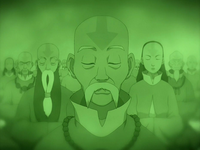
These are Air Nomads as Aang remembered them.
Before the era of the Avatar, the predecessors of the Air Nomads symbolized their belief, by doing the same traditions such as the tattoos yet in a different manner. The tattoos were more polygonal shape with a dot. The clothing that the men wore were orange cloth as a top and yellow as a bottom. Women wore different clothing, yet with the same traditional colors.[10]
The Air Nomads wear yellow, orange and brown clothing. Aang and other young airbenders wore orange shawls over long-sleeved yellow shirts, an orange sash, double-layered pants with brown underneath and a loose yellow layer on top, and high boots that reach just below the knees. Older monks wore long robes in shades of yellow and orange, as well as wooden necklaces with the Air Nomad insignia carved into it. Most Air Nomads have gray or brown eyes and a light complexion.
By 174 AG, the new airbenders from the restored Air Nation had taken to wearing wingsuits, which are colored primarily red, though have yellow and gray accents.[6]
Young boys to be trained as monks have shaven heads, while monk elders grow beards and mustaches; they had the longest and most prominent facial hair of any nation. Female airbenders do not fully shave their heads, just their foreheads so their arrow is visible.[11] Shaving one's head is voluntary, though was encouraged in order to feel the air around them.[12]
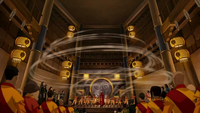
After an airbender has received their tattoos, an anointment ceremony is held to truly declare them a master.
Airbenders who have attained a level of mastery in the art are marked with arrow tattoos, based on the arrows of the sky bison, the first airbenders. A primary arrow tattoo is placed on their shaven head that extends down their back, along with four others, one on each limb that terminates in an arrowhead at the hands and feet.
The arrows mark the paths through which chi travels through the body. Because of this, when an Air Nomad Avatar tattooed in this fashion enters the Avatar State, these tattoos are known to glow, along with the Avatar's eyes and mouth. If the body has received an injury deeper than the tattoo, that spot will no longer glow while in the Avatar State.
National emblem
The Air Nomad insignia is a stylized, swirling orb. Within the circle, coiling lines illustrate the wind. The symbol can be seen on the design of doors and surfaces in the air temples, as well as on pendants of monks' prayer beads.
The Air Nomad flag is a banner held between two wooden poles. The center of the banner is emblazoned with the Air Nomad insignia.
Geography
In the era before the Avatar, the precursors of the Air Nomads lived on top of lion turtles.[10] After leaving the lion turtle city, they were situated on remote mountains in large temples. There were four temples in all, one for each direction on the compass. Two were for and run by males and two were for and run by females. The young boys of the Southern Air Temple were known to travel to the Eastern Air Temple in order to choose their own personal sky bison. This was considered an important choice as the intelligent animals would be with the choosing airbenders for the rest of their lives.[11]
Culture
While other nations possess royalty and are run by monarchies, the Air Nomads were led by the senior monks and nuns of the air temples.[2] Due to the peaceful teachings of their leaders, the nature of the people was calm and tranquil.
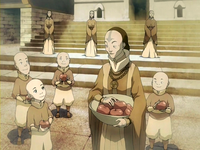
These Air Nomads at the Eastern Air Temple include Aang, who is the small boy located near the bottom left of the picture.
The Air Nomads are the only nation comprised entirely of benders, due to the highly spiritual nature of their lives.[13] Meditation was an important part of the airbenders' daily routines, as it helped them to focus their energies and understand the potency of their element. Due to their high spirituality, the monks believed that hope was only a distraction.[14]
It has been mentioned that they had a good sense of humor, something demonstrated when Monk Gyatso employed a unique teaching method when tutoring Aang with his airbending skills, accurately blowing fruit pies onto other monks' heads as a prank. This activity was useful training and a fun game combined.[15]
The Air Nomads also revered certain events and holidays. such as Yangchen's Festival, which celebrated the Avatar's victory over a dark spirit. The holiday was marked as one of the highest on the Air Nomad calendar and, according to Aang, was also one of the funniest celebrations of their culture.[16]
The arrow tattoos adorning an Air Nomad's body signifies that he or she has mastered airbending. This is an emulation of the natural arrows on the heads of flying bison, who can naturally airbend and are the original teachers of the art, much like the badgermole is to the earthbenders. Aspiring airbenders have no tattoos[2] and in order to receive the tattoos as well as the title of a master, an airbender must pass the thirty-six levels of airbending or engineer a new technique. In actuality, Aang had only reached the thirty-fifth level before he left the Southern Air Temple, but his invention of the air scooter earned him the tattoos prematurely, making him the youngest airbending master in history until his granddaughter, Jinora, earned her tattoos at the age of eleven. Aang's son, Tenzin, later became the first to master the bending art following the Air Nomad Genocide.
In the new Air Nation, an oath of nonaggression was to be declared by a new airbender, by which they swore to adopt the more pacifistic ways of the Air Nomads by using direct combat solely as a last resort.[17]
Season
Each nation of the four nations is influenced by their own distinct, dominant season, in which their bending is at its peak. Autumn is the dominant season of the Air Nomad race. Airbenders are thus at their strongest in this season. More Air Nomad children were born during autumn than any other season, all retaining bending abilities.[18]
Natural resources and foods

Fruit pies were common treats among the Air Nomads.
As could be determined, air is the main power source and natural resource of the Air Nomads. Luckily, air is everywhere, so it is nearly impossible to deprive them of their power source. With the power of air channeled under their control, the airbenders could defend and protect their homes and way of life. Not only could they protect their livelihoods, but these nomads could also ride on their sky bison and glide in the open air, for both leisure and travel. Because the Air Nomads believed all life was precious, they were peaceful vegetarians.[19] They did not seem to mind, however, eating eggs and dairy products. On one occasion, Aang was willing to eat an egg custard tart.[20] They were also known to make sweet dishes such as pies. The Air Nomads sold their pies for money―at one silver piece each―and all the profits were given to charity.[21]
The Air Nomads were a tranquil people who endeavored to preserve the environment around them. Any industry that they invested in, such as farming or gardening, was sustainable and powered naturally, so as to not disturb the balance of nature.
Air Nomad grounds often contained rich mineral deposits filled with iron and crystals. However, due to the non-materialistic culture of the nation, these resources were either barely touched or unknown to its denizens. As such, outsiders like Loban quarried abandoned Air Nomad territory to dig for iron.[16][22]
Government
- Main article: Politics in the World of Avatar
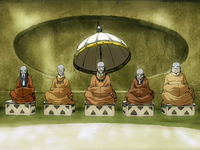
The Southern Air Temple Council of Elders had a prominent place in government.
Government system: Ecclesiastical senate
Head of state and government: Four Councils of Elders
Most recent known head: Four Councils of Elders
Territorial divisions: Four air temples
Heads of territorial divisions: Head monks (Northern and Southern Air Temple) and mothers superior (Eastern and Western Air Temple)
Capital: No overall capital
Unlike the other three nations, which were ruled by royal families and structured governments, each of the Air Nomads' temples were led by respected Councils of Elders. Composed of wise airbending masters, they had little authority in their respective temples, however, they served as counsel for its citizens and airbending instructors.
Air Nation
Government system: Unitary Pseudo-Ecclesiocracy
Head of state and government: No overall head of state; just certain respected individuals
Most recent known head: Tenzin
Territorial divisions: Five air temples
Heads of territorial divisions: Abbots and abbesses
Capital: No overall capital
To preserve the culture of the extinct Air Nomads, Avatar Aang founded the Air Acolytes, a group consisted of mostly Earth Kingdom nonbenders that would uphold Air Nomad philosophies and traditions. After the acolytes' formation, the air temples were each administered by abbots and abbesses.[23]
Following the abolition of the United Republic Council and the airbender boom in 171 AG, Tenzin, by virtue of being the world's most senior airbending master, continued to have a say in global affairs as the figurehead of the Air Nation. He continued to reside on Air Temple Island as he oversaw the growth of the nation, training an increasing number of new airbenders in their bending art.
Military
Contrary to the propaganda spread in the Fire Nation, the Air Nomads did not have any form of military. In fact, they believed in peace and non-violence.[24] Although the Air Nomads did not have any organized fighting force, they still proved to be formidable opponents as Gyatso's skeleton was found surrounded by the remains of several comet-enhanced firebenders he fought against when attacked. Because they were pacifists, Air Nomads led peaceful lives and avoided conflict when possible, though were willing to fight when there was no other option left to take.[15] Aang also mentioned that Fire Lord Sozin defeated the Air Nomads by ambush.[24]
Despite this and their pacifist nature, Tenzin declared, after Avatar Korra was severely physically and psychologically hurt by the Red Lotus' metal poison, that the restored Air Nation adopted the nomadic ways of their predecessors, but with the intention of becoming bringers of peace and balance. Airbender parties scoured the Earth Kingdom after the nation's fall into chaos following Earth Queen Hou-Ting's assassination at the hands of Zaheer in 171 AG.[5] In this capacity, Kai and Opal forcibly halted the escape of three bandits, who were terrorizing the capital of the Earth Kingdom state of Yi, in 174 AG. However, the Air Nation was spread too thin to cover the entirety of the large Earth Kingdom to effectively bring order and balance.[6] Eventually the Air Nation under the leadership of Tenzin participated in the defense of Republic City when the Earth Empire invaded it and were a monumental help in the defeat of Kuvira.
Notable places
- Air Nomad caves
- Air Temple Island
- Eastern Air Temple
- Laghima's Peak
- Northern Air Temple
- Southern Air Temple
- Western Air Temple
- Whaletail Island
Notable figures
Original Air Nomads
This is a list of known Air Nomads and born airbenders prior to Harmonic Convergence of 171 AG.
- Avatar Aang (Southern Air Temple)
- Avatar Yangchen (Western Air Temple)
- Guru Laghima (Northern Air Temple)
- Ikki (Air Temple Island)
- Jinora (Air Temple Island)
- Jinju (Southern Air Temple)
- Meelo (Air Temple Island)
- Monk Gyatso (Southern Air Temple)
- Monk Pasang (Southern Air Temple)
- Monk Tang Xu (Southern Air Temple)
- Monk Tashi (Southern Air Temple)
- Sister Iio (Eastern Air Temple)
- Tenzin (Air Temple Island)
New Air Nation
This is a list of known individuals who obtained airbending abilities after Harmonic Convergence in 171 AG and volunteered to rebuild the Air Nation.
Trivia
- More Air Nomads were born in autumn than in any other season. This is to say, as all Air Nomads are airbenders, that the simple birth of people belonging to the nation was more plentiful,[18] unlike Water Tribe, Fire Nation and Earth Kingdom children who, during their respective seasons, are more often born with bending abilities.[25]
- The Air Nomad culture closely resembles that of Hindu priests and Tibetan monks.